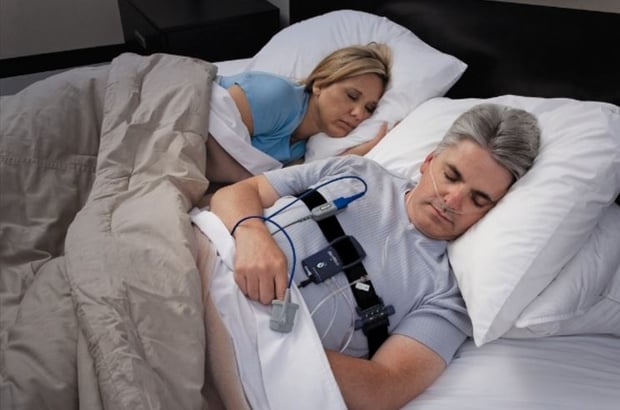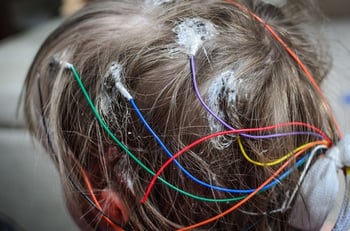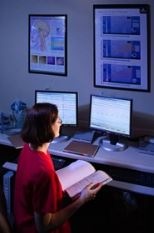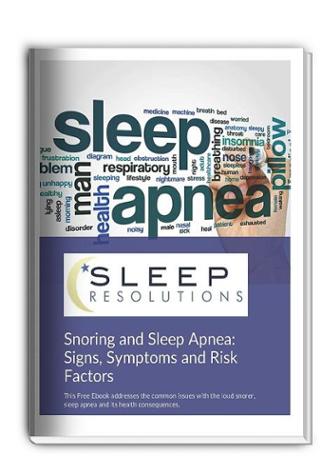 A home sleep test (HST) is a diagnostic test conducted in the patient’s home to confirm obstructive sleep apnea (OSA). Other names for a home sleep test are home sleep study, home sleep apnea test, portable monitoring, and unattended sleep test.
A home sleep test (HST) is a diagnostic test conducted in the patient’s home to confirm obstructive sleep apnea (OSA). Other names for a home sleep test are home sleep study, home sleep apnea test, portable monitoring, and unattended sleep test.
The other diagnostic tool for OSA diagnosis is an in-lab sleep study, which requires an overnight stay in a sleep facility.
The Home Sleep Test Process
Patients who exhibit a high pre-test probability for moderate or severe OSA are excellent candidates for an HST. If the home test results do not indicate sleep apnea, an in-lab test may need to be scheduled to confirm the HST results. HSTs are appropriate for patients who are in fairly good health.
Patients who have other medical conditions such as chronic obstructive pulmonary disease, congestive heart failure, and neuromuscular disease may not be good candidates for an HST and may require an in-lab study.
Patients will either pick up the HST equipment from the sleep center or someone will deliver it to their home. A trained sleep professional will instruct the patient on how to place the devices on their body and what buttons to push.
The person will use the HST device from one night to three nights depending on what the doctor orders, then the patient will return the device to the sleep center.
A sleep professional will analyze the test and forward the results to the physician who will determine a diagnosis. The patient will then meet with the physician to discuss possible treatment options.
What are the Pros and Cons of HST?
Pros
.jpg?width=350&name=shutterstock_382043125%20(1).jpg) Home sleep testing has several advantages.
Home sleep testing has several advantages.
The most convenient for many people is the fact that the test is conducted in the comfort of their own home, so they can sleep in their own bed. The problem of sleeping in a different bed, especially on the first night, is a concern for many people.
Some people are uncomfortable attending an in-lab study for other reasons. They worry about how they will  ever fall asleep with all those wires on their head, face and body (as shown here), and they fret about a sleep technician watching them all night.
ever fall asleep with all those wires on their head, face and body (as shown here), and they fret about a sleep technician watching them all night.
The HST is an excellent tool for offering otherwise reluctant patients, who would resist coming into a lab for a sleep test, a more convenient way to explore the possibility of their having sleep apnea.
With a home sleep study, the patient has a minimum number of wires and sensors. There are many brands of HST devices, but all of them basically measure breathing and blood oxygen. The majority of devices include
- a nasal and oral airflow wire which is like an oxygen cannula,
- two elastic belts that go around the chest and waist,
- an oximeter finger probe that monitors the heart rate and collects oxygen levels during the night
- Some HSTs can also record snoring and body position.
In some in-lab sleep centers there can be a six week wait until a bed is available for a sleep study. For patients who have severe sleep apnea or other urgent needs, this can be an arduous wait. HST offers a quicker diagnostic turn-around time. When time is of the essence, HST holds the advantage.
 For those who must pay out-of-pocket expenses for their health care, HST offers a lower cost alternative. Costs for HST can be one quarter of the cost of an in-lab study. Whereas an in-lab diagnostic study can cost anywhere from $1,000 to $4,000, an HST is more affordable at $150-$800.
For those who must pay out-of-pocket expenses for their health care, HST offers a lower cost alternative. Costs for HST can be one quarter of the cost of an in-lab study. Whereas an in-lab diagnostic study can cost anywhere from $1,000 to $4,000, an HST is more affordable at $150-$800.
With the cost savings and the advancement of device technology, many insurance companies now require an HST be done for sleep apnea diagnosis, unless the patient has certain medical conditions.
Cons
There are some distinct cons to HST, including the design and limitations of the device, the inaccuracy of the results and human error.
The HST device is designed for diagnosing OSA only. The in-lab polysomnogram study, on the other hand, is a more all-encompassing test that can gather data on a number of other sleep behaviors and increase its diagnosing power.
For example, the HST collects information on breathing and oxygen only, but the in-lab sleep study can gather information on not only breathing, but leg movements, other abnormal behavior such as movement disorders, seizures, arousals and fragmented sleep, and one of the most important sleep parameters, whether the patient is actually asleep.
Because the HST cannot detect when the person is actually asleep, it produces inaccurate results on the number of apneas the person has. This inaccuracy underdiagnoses the severity of the sleep apnea. This inaccuracy is especially problematic for patients who have mild sleep apnea, for younger people, for women, and for those with normal body weight. Home sleep testing can underestimate sleep apnea severity by about 10 to 20 percent.
Anoth er technological problem experienced by many HST devices is artifact intrusion that occurs in the sleep study. Artifacts can cause failure rates in 3 to 18 percent of studies. This requires the study to be repeated, which is inconvenient and costly.
er technological problem experienced by many HST devices is artifact intrusion that occurs in the sleep study. Artifacts can cause failure rates in 3 to 18 percent of studies. This requires the study to be repeated, which is inconvenient and costly.
With an HST study, there is no one to watch for problems in the night. Problems such as artifact intrusion, sensors that come off during the night, or that are incorrectly put onto the body in the first place will result in the need for a repeat study.
Many HSTs do have a built-in detection system that causes a beep to be emitted when a sensor gets unattached or if something else is amiss. The beeping can disrupt sleep. Patient unfamiliarity with the device can cause disruption in data collection.
Summary
There are two types of sleep tests that confirm obstructive sleep apnea:.
In-lab studies are done in a sleep facility where a technologist attaches sensors to the patient and monitors behavior and several sleep parameters during the night. The in-lab study gives a very accurate picture of the person’s sleep patterns and indicates sleep apnea and other sleep disorders.
The home sleep test is a convenient, cost effective means to confirm sleep apnea. This test is best for people who have a high pre-test probability of having sleep apnea. If the HST determines the patient does not have sleep apnea, an in-lab study may be recommended to confirm the HST results.
There are limitations to the HST. It is not for everyone. Those with other serious medical conditions will need an in-lab study. HSTs underdiagnose the severity of OSA, cannot determine when the patient is asleep, does not collect information about other sleep disorders or problems the patient may have, is subject to patient error in attaching the sensors, and wires may detach during the night causing inaccurate or unavailable information.
 If you suspect you have sleep apnea, discuss these types of diagnostic tests with your physician to see which is recommended to suit your particular needs.
If you suspect you have sleep apnea, discuss these types of diagnostic tests with your physician to see which is recommended to suit your particular needs.
Sources:
www.sleepeducation.org
Home Sleep Studies, University of Tennessee Sleep Center, http://www.utsleepdisorders.org/tests-procedures/home-sleep-study/
S. Park, 7 Reasons Why I Don’t Like Home Sleep Studies for Sleep Apnea, http://doctorstevenpark.com
Image Credit:
www.shutterstock.com









Leave a comment